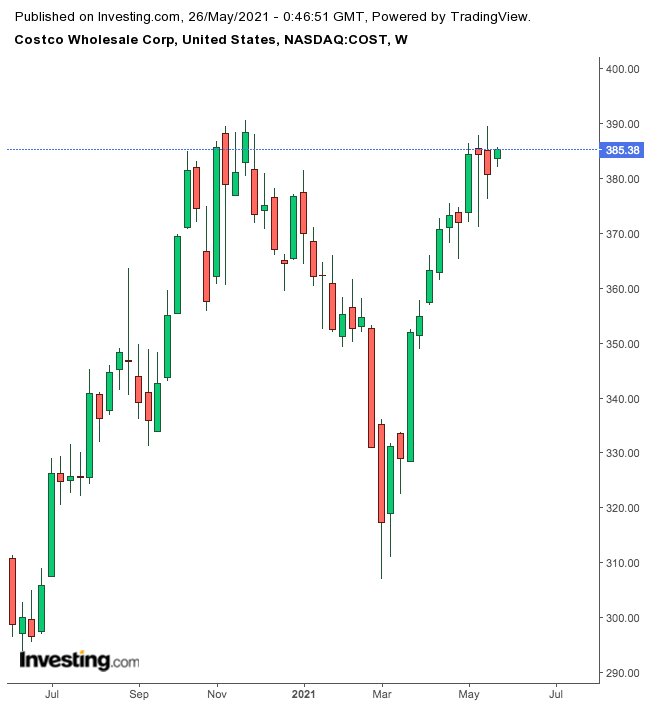- Reports Q3 2021 results on Thursday, May 27, after the close
- Revenue expectation: $43.64 billion
- EPS expectation: $2.31
During the past year, Costco Wholesale (NASDAQ:COST) has been one of the favorite picks for investors. The COVID-19 pandemic provided an unprecedented surge in sales volumes for the international big-box retailer as consumers stocked their pantries to avoid too many trips to stores.

Now that the U.S. is getting closer to containing the pandemic and fully reopening the country's economy, the biggest challenge for Costco is to sustain the gains it made during lockdowns in order to keep its growth-hungry investors satisfied.
When the Washington-based retailer reports its latest earnings tomorrow, the tough, year-over-year comparisons could be the first hurdle as these results will be viewed in contrast to sales starting in March of last year, a time when the outlet benefited from pandemic-era stockpiling and increased cooking from home.
Despite this headline risk, many analysts believe Costco will be able to hold on to its gains in market share. In their view, Costco is a solid long-term defensive play with its extensive store network and its subscription-based retail model that provides stability to its revenue.
With a substantial part of its business focused on selling merchandise at low profit margins, the warehouse shopping club has about 108 million members. In the fiscal year 2020, they paid the company $3.541 billion in membership fees alone. Overall, the retailer generated more than $163 billion in annual sales.
A Core Holding
In a recent note JPMorgan stated Costco continues to be a core holding, given its unrivalled value proposition to its fiercely loyal customer base and global growth opportunity. Oppenheimer analysts also favor Costco for its long-term prospects, citing the company's unique and improving consumer value proposition and its open-ended worldwide growth prospects.
Another reason to stick with Costco stock in the post-pandemic environment is the company’s very lucrative dividend policy. In November, the company announced a record $4.4-billion special distribution. On a per-share basis, that comes out to about $10 per share.
Costco provides a $0.79-a-share quarterly payout at a current yield of 0.84%, which has grown 12.7% per year during the past five years. Its shares, after remaining under pressure in the early part of the year, have gained 13% during the past three months, closing at $385.38 on Tuesday.
There is no doubt that some of the gains Costco made during the pandemic will likely taper off as consumers shift their spending to restaurants and travel. But other sources of revenue that had been held back should return, such as fuel and food-court sales, picking up some slack.
Bottom Line
Costco’s wide economic moat, vast brick-and-mortar empire—which includes stores in the US, Canada, Mexico, the UK parts of continental Europe, Japan, South Korea and even a small presence in China—and its solid membership program make its stock attractive for long-term investors. Any post-earnings weakness could offer a buying opportunity to long-term investors.
